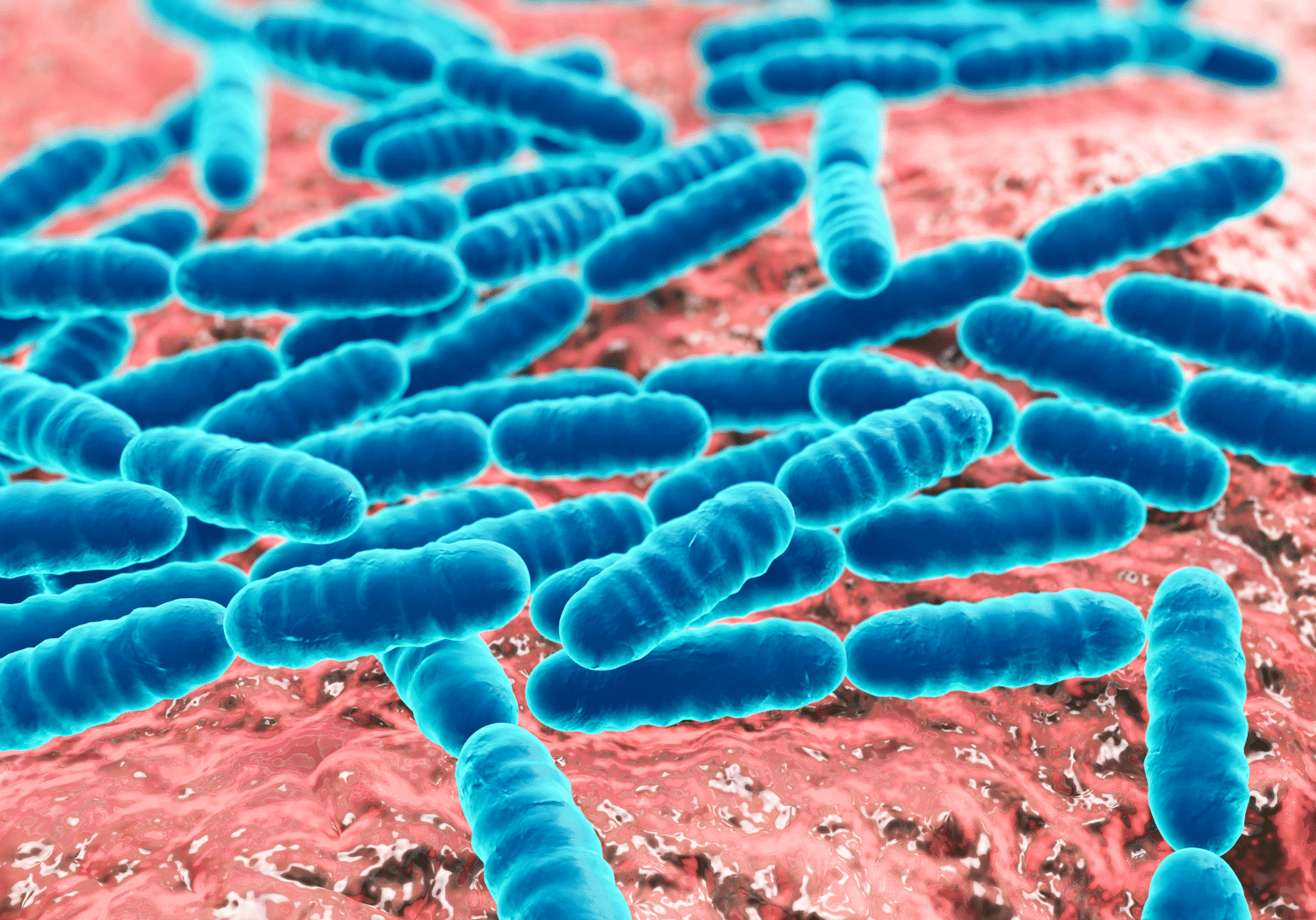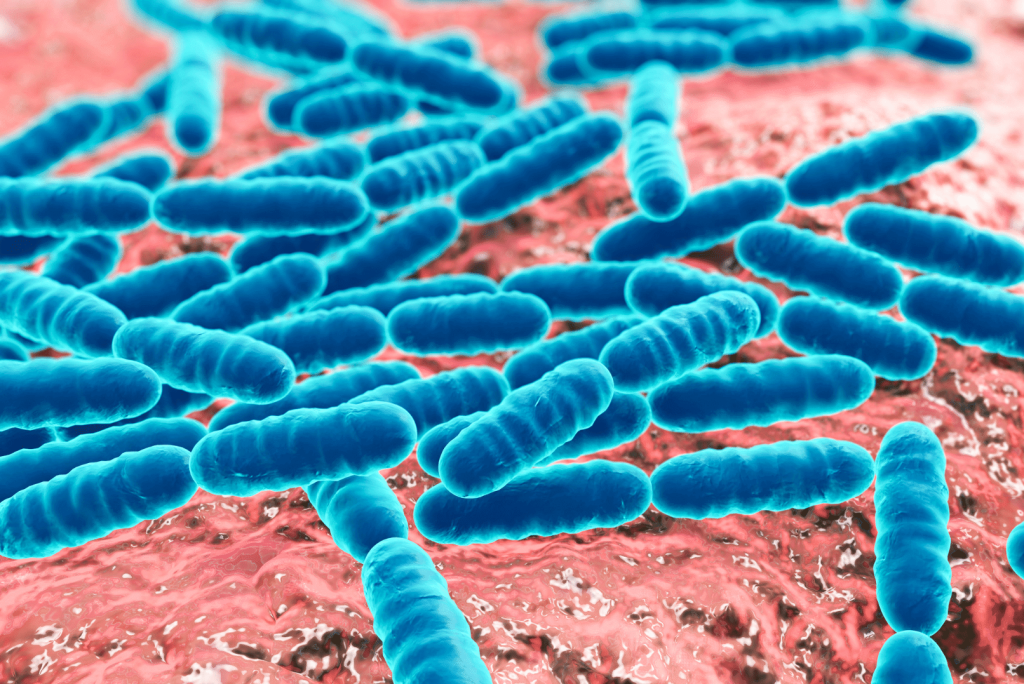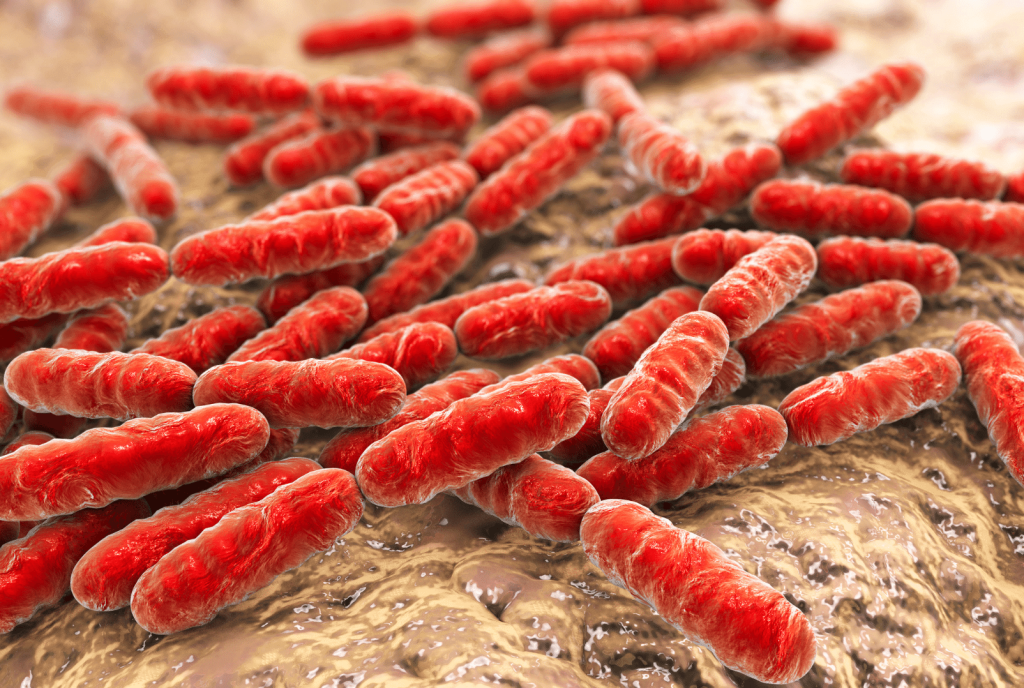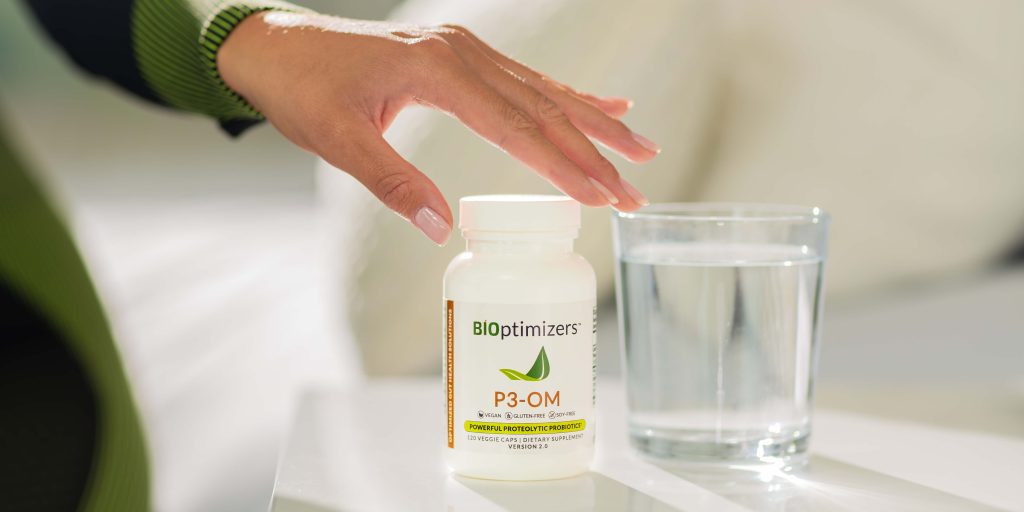Bifidobacteria
Bifidobacteria are a genus of good bacteria that live in normal human microbiota. They deliver many health benefits. This article will cover everything you need to know about Bifidobacteria, and how they positively affect your mental, gut, and overall health.

What Are Bifidobacteria?
Bifidobacteria are Gram-positive bacteria that live in the gut of warm-blooded animals and most mammals, including humans. They are anaerobes, meaning that they live without oxygen
The amount and the different species of Bifidobacteria changes with the age of the host. Bifidobacteria are most abundant in the gut of infants. Adults tend to have much less Bifidobacteria than infants and children, but the levels are relatively constant. Similarly, the species’ composition changes, as some species are more dominant in adulthood than in infancy.
Species that are dominant in infants include B. longum, B. breve, and B. bifidum. However, B. longum is also abundant in adults.
The application of Bifidobacteria as a probiotic shows to improve the health of different organ systems in humans. Let’s see the roles of some Bifidobacterium species.

Bifidobacterium Longum
B. longum is a Bifidobacterium species that lives in the gut. Specifically, B. longum lives in the lower gut, where you have less monosaccharides and disaccharides. That is why this bacterium has a lot of genes for oligosaccharide metabolism.
B. longum changes its gene readouts a lot, probably to respond and adapt faster to the changing nutrient levels in the gut.
B. longum, itself, includes 3 more subspecies: longum, infantis, and suis We will focus on subspecies longum and infantis because they inhabit the human GI tract.
Health Benefits Of B. Longum Subspecies Longum
Improves Gut Health And Regularity
Bifidobacteria, as a part of normal gut microbiota, maintain gut health. Consumption of dairy products containing B. longum spp longum makes constipated people go more often while they are taking the probiotics.
A 16-week study included 123 older adults, divided into 3 groups:
- Placebo group
- Lower dose of B. longum (25 billion colony-forming units) group
- Higher dose of B. longum (50 billion colony-forming units) group
Individuals that received either low or high doses of B. longum experienced gastrointestinal benefits. It seemed to have normalizing benefits. Those who pooped less often experienced increased bowel movements. Whereas those who pooped more often experienced less bowel movements. Therefore, B. longum balances the intestinal environment and bowel movements.
Antibiotic treatment should be accompanied by probiotics to support a healthy gut flora. In a study testing the ability of B. longum to support gut flora restoration after antibiotics, ten healthy adults received antibiotic treatment. One group also received a placebo, while the other group received a yogurt containing B. longum. The B. longum group experienced less abdominal discomfort and defecation frequency than in the placebo group.
High fecal pH might indicate a deficiency in healthy gut bacteria. High levels of β-glucuronidase can be a sign of negative changes within the colon. Five healthy participants received B. longum for 5 weeks. Fecal pH, ammonia concentration, and β-glucuronidase levels dropped during the B. longum supplementation.
Furthermore, B. longum protects from DNA damage in the gut lining. In rat colon cells exposed to chemicals that damage DNA, pretreatment with B. longum inhibited some of this damage.
Supports Healthy And Balanced Immune Function
A study compared stool samples from 99 children with allergies (allergic dermatitis and asthma) with stools of 102 healthy children underwent analysis. They found that healthy children had more B. longum (30.3%) than allergic children (11.1%). This data is not enough to say that B. longum supplementation can help with allergies. However, having B. longum in the gut likely supports a healthy inflammatory response.
In a mouse model of leaky gut, B. longum mitigated the gut lining damage due to bacteria toxins normally present in the gut. B. longum promoted a balanced, healthy inflammatory response to these bacterial toxins.
Moreover, an intact barrier between the intestinal epithelial cells is necessary for health. This barrier prevents the entry of harmful molecules and bacteria into the bloodstream. Tight junctions provide this great barrier, but mild inflammation from food or normal gut bacteria can disrupt the tight junctions. Supplementation with B. longum seems to strengthen the gut barrier and support a balanced inflammatory response
Mood And Mental Health
Subspecies longum has positive effects on mood and promotes relaxation. Bifidobacterium longum supports mental health through the gut-brain axis.
Furthermore, this bacterium might modulate a healthy stress response. A study included 40 healthy participants to investigate the effects of B. longum on social stress. Participants received either 1 billion colony-forming units of B. longum or a placebo for 4 weeks.
Individuals that received B. longum had stronger theta brain waves in resting state. This indicates a healthy response to stress and calmness, as well as reduced mental fatigue.
Another study demonstrated the effects of B. longum supplementation on cognition. 22 participants first received a placebo for 4 weeks, and then 1 billion colony-forming units of B. longum for another 4 weeks. Visuospatial memory slightly improved. Additionally, participants reported increased feelings of calmness.
Supports Healthy Cholesterol Levels
A study demonstrated how B. longum-fermented milk affects cholesterol levels in rats, as well as human participants.
In the rat study, healthy rats received a diet high in cholesterol and supplementation (just milk or B. longum-fermented milk) for 3 weeks. Serum analysis showed that B. longum supplementation supports healthy cholesterol levels within normal ranges. LDL levels dropped, while HDL levels remained the same.
In regards to the human study, 32 healthy participants received either a low-fat yogurt containing B. longum, or 2 different bacterial species. Similar outcomes occurred as in the rat study: B. longum promoted healthy cholesterol levels within normal ranges.
Bone Strength
A number of cell culture and animal studies presented the role of B. longum in bone health. A rat study showed that the B. longum-treated group had higher magnesium and calcium levels in their bones. The same group had 8.6% stronger and more durable bones compared to the control group.
Additionally, B. longum inhibited osteoclast formation in a mouse study. Osteoclasts are cells that naturally degrade bone tissues.

Health Benefits Of B. longum Subspecies infantis
Bifidobacterium infantis inhabits the gut of infants where it helps the digestion of human milk oligosaccharides. It exerts the majority of beneficial effects like B. longum. However, those are not the only ones. Let’s see some other benefits.
Relieves Abdominal Discomfort
A study included 275 individuals with abdominal discomfort and bloating more than twice a week. They received 1 billion colony-forming units of B. infantis for 4 weeks. Bloating and abdominal discomfort significantly dropped during the supplementation period.
One of the ways B. infantis relieves abdominal discomfort is by promoting a balanced inflammatory response.
B. infantis may also help with stress-related digestive issues. 53 participants with abdominal issues after a stressful event received either B. infantis or nothing for 3 months. As B. infantis restored the microbiota balance, it promoted relaxation and boosted the mood through the gut-brain axis
Preserves Gastrointestinal Integrity
The entry of foreign organisms or substances into the GI tract disrupts the balance. B. infantis can preserve the integrity of the tract by boosting a healthy immune response and inhibiting suboptimal microbes.
Bifidobacterium Adolescentis
B. adolescentis bacteria normally live in the gut of adults. It is important for gastrointestinal health, but also exerts other beneficial effects. Keep in mind that most studies for this strain are in animals, and we need more clinical trials to confirm their benefits in humans.
Health Benefits
Occasionally Alleviates Constipation And Promotes Regularity
B. adolescentis can occasionally help with constipation. In one study, mice received 3 B. adolescentis strains for 17 days. Two of those strains relieved constipation at times. B. adolescentis bound to the gut wall and increased lactobacilli. The increase in lactobacilli alleviates constipation.
Stimulates GABA Production
Certain strains of B. adolescentis enhance GABA production. In an experiment, 79% of B. adolescentis strains efficiently converted monosodium glutamate (GABA precursor) to GABA. Furthermore, 23% of the strains obtained the classification of high GABA producers.
In one study, rats received these GABA-producing B. adolescentis strains for 5 days. Rats had an increase in the activity of genes coding for GABA synthesis. The increase was between 1.5 and 7-fold.
Healthy Glucose Metabolism
In a mouse study, mice received a high-fat diet with different Bifidobacterium strains for 12 weeks. The B. adolescentis-group had lower fasting blood glucose levels and better glucose intolerance. Therefore, B. adolescentis strains also improved the insulin sensitivity in mice.
Bifidobacterium Bifidum
Bifidobacterium bifidum, first isolated more than 60 years ago, lives in infant and adult guts. As opposed to B. longum, B. bifidum has far fewer genes that produce carbohydrate-digesting enzymes. This bacterium can bind to GI lining using its pili, which are the basis of interaction with the human host. In addition, B. bifidum supports the growth of other Bifidobacteria within the infant gut.
Health Benefits
Intestinal And Stomach Wellbeing
A study enrolled healthy individuals with occasional stomach issues. In the first open trial of the study, 305 individuals with or without abdominal discomfort received B. bifidum-fermented milk for 2 weeks. Their stomach discomfort improved from 45% (baseline) to 28%. Tummy issues also improved from from 58% to 40% after 2 weeks of supplementation.
The second placebo-controlled crossover trial included 27 participants with stomach issues. They received either B. bifidum-fermented milk or a placebo for 2 weeks. The B. bifidum group had significantly less stomach issues when compared to the placebo group.
Balanced Stress Response
581 students received 3 billion colony-forming units of B. bifidum for 6 weeks. Students taking B. bifidum reported more ‘’healthy days’’ when compared to the control group. Furthermore, participants also scored lower stress levels, suggesting the stress-balancing effect of B. bifidum.
Bifidobacterium Breve
Bifidobacterium breve is another species associated with the gut microbiota as well as the urogenital system. Let’s see how it affects our health.
Health Benefits
Urogenital Health
Bifidobacteria species, including B. breve, also reside in the vaginal microbiota. There is a potential that Bifidobacteria support vaginal health.
In the test tubes, B. breve isolated from a healthy woman’s vaginal swab inhibited the growth of urogenital pathogens. However, we still need more studies in humans to confirm the health benefits of B. breve.
Healthy Weight And Metabolism
In one study, mice ate a high-fat diet with B. breve supplementation (100 million or 1 billion colony-forming units per dose) for 8 weeks. Supplementation mitigated some increase in body weight. Furthermore, B. breve supported healthy cholesterol levels and enhanced the expression of genes for fat metabolism. Higher dosage (1 billion colony-forming units) was more beneficial than the lower dose. This indicates that the effects could be dose-dependent.
Another study included 80 healthy pre-obese adults. They received either a placebo or 20 billion colony-forming units of B. breve for 12 weeks. Body fat mass was significantly lower in the B. breve group, with slight improvement in HDL cholesterol levels. The placebo group experienced a significant increase in fat area.
This shows the role of B. breve in supporting healthy weight and metabolism. Although the results were statistically significant, the average difference in body fat was only ~0.6 kg between the groups when diet and exercise remained the same. This was a modest amount of fat loss in 12 weeks, which would’ve been significantly improved along with diet and exercise.
Protects DNA
Just like B. longum, B. breve protects the gut lining cell’s DNA from damaging chemicals in test tube studies.
Mental Health Benefits
B. breve can benefit your mental health in a variety of ways. Some strains produce neuromodulatory metabolites, like tryptophan and nicotinate. In addition, B. breve can reshape the gut microbiota to improve mood, mental stamina, and stress response.
79 individuals participated in a study investigating B. breve effects on cognition. Participants received 20 billion colony-forming units of B. breve or a placebo for 16 weeks. The B. breve group experienced a significant improvement in memory, cognition, and executive function.
The follow-up study demonstrated that there is a correlation between enhanced cognition and lower plasma hemoglobin A1c in the B. breve participant group. B. breve possibly does this by promoting a balanced inflammatory response.
Promoting Healthy Immune Response
B. breve can benefit and support your immune system:
- It stimulates the production of IgA antibodies associated with mucosal immunity.
- B. breve improves the intestinal barrier, and thus preserves intestinal integrity.
- It enhances naive T cell homing into lymph nodes. This increases the probability of T cells meeting an intruder.
- This bacterium can activate regulatory T cells, which promotes immune balance.
- It promotes a healthy inflammatory response (increases interferon gamma, decreases interleukin 1 and interleukin 6).
A trial included 130 pregnant women who started to receive B. breve 1 month before delivery. Women then administered B. breve to their infants for 6 months. Infant health significantly improved in the B. breve group when compared to the control group.
Additionally, immune-supportive effects of B. breve can support our immune system’s natural ability to inhibit uncontrolled and unhealthy cell growth.
Gastrointestinal Tract Loves B. Breve
B. breve, an inhabitant of the human gut, promotes gastrointestinal regularity. A study included 971 infants who received standard infant formula or the formula fermented with B. breve for 5 months. The infant that received B. breve experienced less frequent diarrhea and dehydration (2.5%) than the control group (6.1%).
A mouse study dealt with B. breve effects on intestinal homeostasis. B. breve inhibited the secretion of some intestinal chemokines and pro-inflammatory cytokines. The study suggested that B. breve improved on intestinal homeostasis and promotes a balanced inflammatory response.

Bifidobacterium Animalis Subspecies Lactis
Another member is Bifidobacterium animalis, and we will focus on subspecies lactis. It originates from commercial yogurt.
Health Benefits
B. lactis has the ability to balance the gut microbiota and exert beneficial effects. For instance:
- With its stable presence in the adult microbiota, B. lactis supports intestinal metabolic processes, like lipid metabolism and vitamin production.
- It promotes epithelial integrity in the intestines, thus enhancing the barrier against foreign particles.
- B. lactis can occasionally relieve constipation.
- It supports your cardiovascular health.
- This bacterium interacts with the immune system and optimizes the inflammatory response.
In addition, B. lactis can help in weight management. 225 volunteers received a placebo, dietary fiber, B. lactis, or dietary fiber + B. lactis for 6 months. Dietary fiber + B. lactis group showed a 4.5% decrease in the body fat mass compared to the control. In addition, the B. lactis group only showed a reduction in energy intake compared to the placebo group.
Bifidobacterium Dentium
B. dentium is another member of the intestinal microbiome. However, it can also live in the oral cavity, where it acts as a cariogen (induces tooth decay).
Health Benefits:
- B. dentium can enhance GABA secretion.
- It enhances the mucosal layer in intestines.
What Foods Contain Bifidobacteria?
After seeing all the benefits, now you might be wondering how to ensure the intake of Bifidobacteria. Basically, all fermented foods contain Bifidobacteria, but specifically:
- Yogurt (with added Bifidobacteria cultures)
- Kefir
- Pickles
- Kimchi
- Sourdough bread
- Sauerkraut
You can also try Bifidobacteria in the form of probiotics. For example, our Cognibiotics and Biome Breakthrough contain some of these mentioned Bifidobacteria.
- Leahy SC, Higgins DG, Fitzgerald GF, van Sinderen D. Getting better with bifidobacteria. J Appl Microbiol. 2005;98(6):1303-1315. doi:10.1111/j.1365-2672.2005.02600.x
- Arboleya S, Watkins C, Stanton C, Ross RP. Gut bifidobacteria populations in human health and aging. Front Microbiol. 2016;7:1204. doi:10.3389/fmicb.2016.01204
- Schell MA, Karmirantzou M, Snel B, et al. The genome sequence of Bifidobacterium longum reflects its adaptation to the human gastrointestinal tract. Proc Natl Acad Sci U S A. 2002;99(22):14422-14427. doi:10.1073/pnas.212527599
- Floch MH, Ringel Y, Allan Walker W. The Microbiota in Gastrointestinal Pathophysiology. Elsevier Inc.; 2017.
- Wong CB, Odamaki T, Xiao JZ. Beneficial effects of Bifidobacterium longum subsp. longum BB536 on human health: Modulation of gut microbiome as the principal action. J Funct Foods. 2019;54:506-519. doi:10.1016/j.jff.2019.02.002
- Kondo J, Xiao JZ, Shirahata A, et al. Modulatory effects of Bifidobacterium longum BB536 on defecation in elderly patients receiving enteral feeding. World J Gastroenterol. 2013;19(14):2162-2170. doi:10.3748/wjg.v19.i14.2162
- Colombel JF, Cortot A, Neut C, Romond C. Yoghurt with Bifidobacterium longum reduces erythromycin-induced gastrointestinal effects. Lancet. 1987;330(8549):43. doi:10.1016/s0140-6736(87)93078-9
- Benno Y, Mitsuoka T. Impact of Bifidobacterium longum on human fecal microflora. Microbiol Immunol. 1992;36(7):683-694. doi:10.1111/j.1348-0421.1992.tb02071.x
- Pool-Zobel BL, Neudecker C, Domizlaff I, et al. Lactobacillus- and bifidobacterium-mediated antigenotoxicity in the colon of rats. Nutr Cancer. 1996;26(3):365-380. doi:10.1080/01635589609514492
- Akay HK, Bahar Tokman H, Hatipoglu N, et al. The relationship between bifidobacteria and allergic asthma and/or allergic dermatitis: a prospective study of 0-3 years-old children in Turkey. Anaerobe. 2014;28:98-103. doi:10.1016/j.anaerobe.2014.05.006
- Dong J, Ping L, Cao T, et al. Immunomodulatory effects of the Bifidobacterium longum BL-10 on lipopolysaccharide-induced intestinal mucosal immune injury. Front Immunol. 2022;13:947755. doi:10.3389/fimmu.2022.947755
- Yao S, Zhao Z, Wang W, Liu X. Bifidobacterium longum: Protection against inflammatory bowel disease. J Immunol Res. 2021;2021:8030297. doi:10.1155/2021/8030297
- Messaoudi M, Violle N, Bisson JF, Desor D, Javelot H, Rougeot C. Beneficial psychological effects of a probiotic formulation (Lactobacillus helveticusR0052 andBifidobacterium longumR0175) in healthy human volunteers. Gut Microbes. 2011;2(4):256-261. doi:10.4161/gmic.2.4.16108
- Wang H, Braun C, Murphy EF, Enck P. Bifidobacterium longum 1714TM strain modulates brain activity of healthy volunteers during social stress. Am J Gastroenterol. 2019;114(7):1152-1162. doi:10.14309/ajg.0000000000000203
- Allen AP, Hutch W, Borre YE, et al. Bifidobacterium longum 1714 as a translational psychobiotic: modulation of stress, electrophysiology and neurocognition in healthy volunteers. Transl Psychiatry. 2016;6(11):e939-e939. doi:10.1038/tp.2016.191
- Xiao JZ, Kondo S, Takahashi N, et al. Effects of milk products fermented by Bifidobacterium longum on blood lipids in rats and healthy adult male volunteers. J Dairy Sci. 2003;86(7):2452-2461. doi:10.3168/jds.S0022-0302(03)73839-9
- Rodrigues FC, Castro ASB, Rodrigues VC, et al. Yacon flour and Bifidobacterium longum modulate bone health in rats. J Med Food. 2012;15(7):664-670. doi:10.1089/jmf.2011.0296
- Wallimann A, Hildebrand M, Groeger D, et al. An exopolysaccharide produced by Bifidobacterium longum 35624® inhibits osteoclast formation via a TLR2-dependent mechanism. Calcif Tissue Int. 2021;108(5):654-666. doi:10.1007/s00223-020-00790-4
- Ringel-Kulka T, McRorie J, Ringel Y. Multi-center, double-blind, randomized, placebo-controlled, parallel-group study to evaluate the benefit of the probiotic Bifidobacterium infantis 35624 in non-patients with symptoms of abdominal discomfort and bloating. Am J Gastroenterol. 2017;112(1):145-151. doi:10.1038/ajg.2016.511
- Brenner DM, Chey WD. Bifidobacterium infantis 35624: a novel probiotic for the treatment of irritable bowel syndrome. Rev Gastroenterol Disord. 2009;9(1):7-15. https://europepmc.org/article/med/19367213
- Ma ZF, Yusof N, Hamid N, et al. Bifidobacterium infantis M-63 improves mental health in victims with irritable bowel syndrome developed after a major flood disaster. Benef Microbes. 2019;10(2):111-120. doi:10.3920/BM2018.0008
- Chenoll E, Rivero M, Codoñer FM, et al. Complete Genome Sequence of Bifidobacterium longum subsp. infantis Strain CECT 7210, a Probiotic Strain Active against Rotavirus Infections. Genome Announc. 2015;3(2). doi:10.1128/genomeA.00105-15
- Ruiz L, Flórez AB, Sánchez B, et al. Bifidobacteriumlongum subsp. infantis CECT7210 (B. infantis IM-1®) Displays In Vitro Activity against Some Intestinal Pathogens. Nutrients. 2020;12(11):3259. doi:10.3390/nu12113259
- Wang L, Hu L, Xu Q, et al. Bifidobacterium adolescentis exerts strain-specific effects on constipation induced by loperamide in BALB/c mice. Int J Mol Sci. 2017;18(2):318. doi:10.3390/ijms18020318
- Duranti S, Ruiz L, Lugli GA, et al. Bifidobacterium adolescentis as a key member of the human gut microbiota in the production of GABA. Sci Rep. 2020;10(1):14112. doi:10.1038/s41598-020-70986-z
- Qian X, Si Q, Lin G, et al. Bifidobacterium adolescentis is effective in relieving type 2 diabetes and may be related to its dominant core genome and gut Microbiota modulation capacity. Nutrients. 2022;14(12). doi:10.3390/nu14122479
- Quigley EMM. Bifidobacterium bifidum. In: Floch MH, Ringel Y, Allan Walker W, eds. The Microbiota in Gastrointestinal Pathophysiology. Elsevier; 2017:131-133.
- Turroni F, Duranti S, Milani C, Lugli GA, van Sinderen D, Ventura M. Bifidobacterium bifidum: A key member of the early human gut Microbiota. Microorganisms. 2019;7(11):544. doi:10.3390/microorganisms7110544
- Gomi A, Iino T, Nonaka C, Miyazaki K, Ishikawa F. Health benefits of fermented milk containing Bifidobacterium bifidum YIT 10347 on gastric symptoms in adults. J Dairy Sci. 2015;98(4):2277-2283. doi:10.3168/jds.2014-9158
- Langkamp-Henken B, Rowe CC, Ford AL, et al. Bifidobacterium bifidum R0071 results in a greater proportion of healthy days and a lower percentage of academically stressed students reporting a day of cold/flu: a randomised, double-blind, placebo-controlled study. Br J Nutr. 2015;113(3):426-434. doi:10.1017/S0007114514003997
- Bottacini F, O’Connell Motherway M, Kuczynski J, et al. Comparative genomics of the Bifidobacterium breve taxon. BMC Genomics. 2014;15(1):170. doi:10.1186/1471-2164-15-170
- Freitas AC, Hill JE. Quantification, isolation and characterization of Bifidobacterium from the vaginal microbiomes of reproductive aged women. Anaerobe. 2017;47:145-156. doi:10.1016/j.anaerobe.2017.05.012
- Giordani B, Melgoza LM, Parolin C, et al. Vaginal Bifidobacterium breve for preventing urogenital infections: Development of delayed release mucoadhesive oral tablets. Int J Pharm. 2018;550(1-2):455-462. doi:10.1016/j.ijpharm.2018.09.003
- Kondo S, Xiao JZ, Satoh T, et al. Antiobesity effects of Bifidobacterium breve strain B-3 supplementation in a mouse model with high-fat diet-induced obesity. Biosci Biotechnol Biochem. 2010;74(8):1656-1661. doi:10.1271/bbb.100267
- Minami J, Iwabuchi N, Tanaka M, et al. Effects of Bifidobacterium breve B-3 on body fat reductions in pre-obese adults: a randomized, double-blind, placebo-controlled trial. Biosci Microbiota Food Health. 2018;37(3):67-75. doi:10.12938/bmfh.18-001
- Tian P, Bastiaanssen TFS, Song L, et al. Unraveling the microbial mechanisms underlying the psychobiotic potential of a Bifidobacterium breve strain. Mol Nutr Food Res. 2021;65(8):e2000704. doi:10.1002/mnfr.202000704
- Xiao J, Katsumata N, Bernier F, et al. Probiotic Bifidobacterium breve in improving cognitive functions of older adults with suspected mild cognitive impairment: A randomized, double-blind, placebo-controlled trial. J Alzheimers Dis. 2020;77(1):139-147. doi:10.3233/JAD-200488
- Bernier F, Ohno K, Katsumata N, Shimizu T, Xiao J. Association of plasma hemoglobin A1c with improvement of cognitive functions by probiotic Bifidobacterium breve supplementation in healthy adults with mild cognitive impairment. J Alzheimers Dis. 2021;81(2):493-497. doi:10.3233/JAD-201488
- Cukrowska B, Bierła JB, Zakrzewska M, Klukowski M, Maciorkowska E. The relationship between the infant gut Microbiota and allergy. The role of Bifidobacterium breve and prebiotic oligosaccharides in the activation of anti-allergic mechanisms in early life. Nutrients. 2020;12(4):946. doi:10.3390/nu12040946
- Sivan A, Corrales L, Hubert N, et al. Commensal Bifidobacterium promotes antitumor immunity and facilitates anti-PD-L1 efficacy. Science. 2015;350(6264):1084-1089. doi:10.1126/science.aac4255
- Thibault H, Aubert-Jacquin C, Goulet O. Effects of long-term consumption of a fermented infant formula (with Bifidobacterium breve c50 and Streptococcus thermophilus 065) on acute diarrhea in healthy infants. J Pediatr Gastroenterol Nutr. 2004;39(2):147-152. doi:10.1097/00005176-200408000-00004
- Heuvelin E, Lebreton C, Grangette C, Pot B, Cerf-Bensussan N, Heyman M. Mechanisms involved in alleviation of intestinal inflammation by bifidobacterium breve soluble factors. PLoS One. 2009;4(4):e5184. doi:10.1371/journal.pone.0005184
- Cheng J, Laitila A, Ouwehand AC. Bifidobacterium animalis subsp. lactis HN019 Effects on Gut Health: A Review. Front Nutr. 2021;8:790561. doi:10.3389/fnut.2021.790561
- Uusitupa HM, Rasinkangas P, Lehtinen MJ, et al. Bifidobacterium animalis subsp. lactis 420 for Metabolic Health: Review of the Research. Nutrients. 2020;12(4):892. doi:10.3390/nu12040892
- Stenman LK, Lehtinen MJ, Meland N, et al. Probiotic with or without fiber controls body fat mass, associated with serum zonulin, in overweight and obese adults-randomized controlled trial. EBioMedicine. 2016;13:190-200. doi:10.1016/j.ebiom.2016.10.036
- Ventura M, Turroni F, Zomer A, et al. The Bifidobacterium dentium Bd1 genome sequence reflects its genetic adaptation to the human oral cavity. PLoS Genet. 2009;5(12):e1000785. doi:10.1371/journal.pgen.1000785
- Engevik MA, Luk B, Chang-Graham AL, et al. Bifidobacterium dentium fortifies the intestinal mucus layer via autophagy and calcium signaling pathways. MBio. 2019;10(3). doi:10.1128/mBio.01087-19






